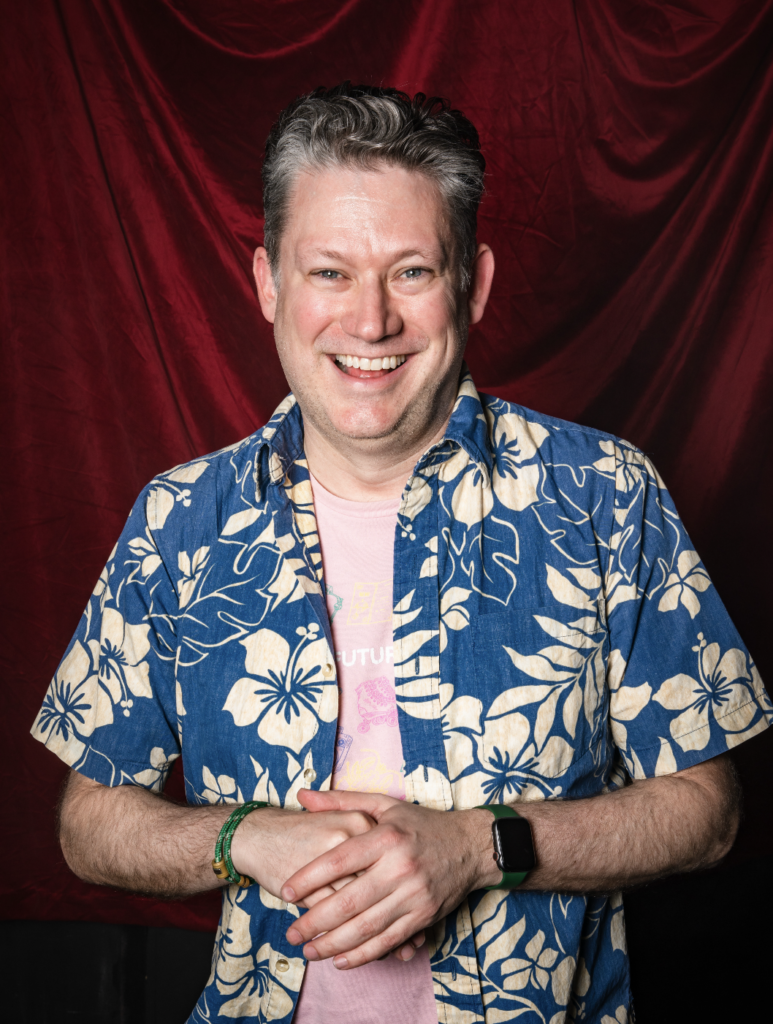How do Arts Organizations balance the worlds of Art & Admin? From applying for funding to producing productions and all the in-between, it’s a circus act trying to keep all the plates spinning in the air at once.
I had the honor of speaking with Rob, who was originally cast as a Neo-Futurist in 1995 and became a New York Neo-Futurist in 2004. 30 years! That’s something else: longevity and dedication. If you don’t know the New York Neo-Futurists, they are best known for THE INFINITE WRENCH, which is an ongoing, ever-changing attempt to perform 30 plays in 60 minutes. Each play offers something different, be it funny, profound, elegant, disgusting, topical, irreverent, terrifying, musical, or any combination of the above. All are original and tackle the here-and-now, written by the performers, with new plays every week, 50 weeks a year, since 1988 in Chicago and 2004 in NYC.

Today, the Neo-Futurists have companies in New York, San Francisco, and Chicago. They are artistically linked, but financially and administratively separate. Rob and I discussed what it means to balance art and admin at the New York Neo-Futurists, and what gets in the way of that.
A Collective Model: Freedom & Friction
The NY Neo-Futurists operate as a collective of 25 ensemble members with committees ranging from fundraising to audience development. Rob has been the only paid staff member handling production and administrative oversight, while ensemble members receive a stipend for the weeks they are in the show and hourly pay for their committee and production support work. The company is in the process of adding new part-time staff members.
This structure fosters ownership: artists get to create with minimal financial risk and feel genuine buy-in. But it also creates challenges. As Rob put it:
“People need to know how to be on a committee, and they need to be taught
how to be in a collective.”
Not everyone comes in with admin skills, and Human Resources (HR) support is nearly nonexistent in small theatre companies. When interpersonal conflict arises, there’s no formal infrastructure to address it. Turns out that the lack of HR is one of the bigger issues at NY Neo-Futurist, and they are not alone in this. HR infrastructure isn’t just “nice to have,” but fundamental.
Why Theatre Needs Better HR and Currently Doesn’t Have It
If you’ve been following Broadway lately, you know performers and musicians were on the brink of a strike over health care and fair conditions. It’s a similar story, just scaled up. What’s different, of course, is that small theatres aren’t fighting for union contracts or healthcare coverage – but the underlying issue is the same. It takes more time, people, training, and, frankly, money to sustain arts organizations than most people think. The result is that we shift the cost of sustainability – emotional and financial – onto the artists.
Most arts organizations don’t have HR departments because they were never designed as workplaces; they were built as creative communities. But once you start paying people, managing teams, and handling conflict, HR isn’t optional – it’s essential.
Theatre is personal by nature. The work asks artists to be themselves, to take risks, to collaborate deeply. That same openness can make boundaries blur and tensions rise. Without HR systems – or even shared language for conflict resolution – companies end up relying on goodwill instead of structure.
The Broadway negotiations highlight a truth every arts organization faces: sustainability isn’t just about funding art, it’s about supporting the people who make it. HR is one of the missing tools to help us do exactly that.
What Shapes the “Good” vs. the “Bad”?
Rob pointed to a few key factors that shape how well the balance between art and admin is maintained:
- Delegation: Works best with seasoned members who know the ropes, but training new members takes time and energy.
- Financial Support: Grants and development staff can make or break admin stability. Still, funding often comes with strings attached: applications, reports, and compliance work that create more admin.
- Interpersonal Relationships: When conflict isn’t managed well, everything suffers. With a collective model, disagreements can quickly bleed into the art itself.
- Burnout & Turnover: Admin roles tend to experience higher turnover than creative roles, leading to gaps in institutional knowledge and more “firefighting mode.”
Why Admin Always Falls Behind
So, why is it that Arts Organizations always seem to outgrow their infrastructure? More and more people want to join, and they do, but somehow the admin can’t keep up with the demand, especially when there are limited funds to go around. An organization with an artistic mission will naturally invest new dollars first in creative work, but it must also find a way to allocate a percentage to the increasing needs of administration in a growing organization. Even with structure, committees, and digital tools like Slack and Notion, some areas inevitably fall through the cracks. In Rob’s experience these include:
- Audience development (particularly among younger audiences)
- Donor relations (Rob has been essentially doing this solo)
- Researching new grants
Rob noted that having a dedicated General Manager will help the company stabilize, but right now, admin work is constantly playing catch-up.
“It’s like the little boy with his finger in the dam,” he said.
“We’re always plugging leaks rather than building a new system.”
The Bigger Picture
At the heart of the struggle is a deeper truth: art needs administrators to survive, and both art and administration cost more money than most cultural organizations can raise. Theatre companies frequently outgrow their infrastructure because new funding is often focused on expanding creative projects with new artists, shows, and audiences. At the same time, the administrative systems are often overlooked and underfunded. While we won’t discuss the many reasons for this here (project-focused grantors, a lack of understanding around arts admin, etc), Rob’s experience at the New York Neo-Futurists does suggest some potential solutions.
Artists may not enter the field considering themselves administrators, but that doesn’t mean they can’t gain the skills with proper training. In fact, at Benvenuti Arts, we rarely meet artists who haven’t already developed entrepreneurial skills, although they often do not consider them as such. (What is producing if it isn’t project management?) But without systemic supports like HR, capacity funding, or admin training, companies like the NY Neo-Futurists will continue to face this delicate, sometimes impossible balancing act.
Balancing art and admin isn’t a problem to be solved – it’s an ongoing process that shifts with people, funding, and time. What worked in the past may no longer work as the world changes, as Rob noted above with the NY Neo-Futurists’ recent goal of adding operations staffing. The NY Neo-Futurists demonstrate that ownership and creativity flourish when artists have genuine support behind them. Investing in structure, HR, training, and care doesn’t detract from the art. It protects it.


